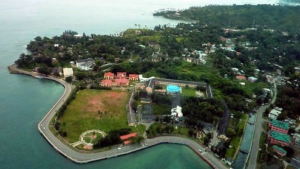https://theworldfinancialforum.com/participate/
Earthquake in Andaman Nicobar
A earthquake with a magnitude of 6.2 struck the Andaman and Nicobar Islands early Tuesday, news agency Reuters reported citing German Research Centre for Geosciences (GFZ).
The quake occurred at a depth of 10 kilometres (6.21 miles), GFZ reported. As of now, there have been no immediate reports of damage or casualties.
Authorities are monitoring the situation closely, and disaster response teams are on alert in the region, which lies in a seismically active zone. More updates here

n the hushed hours of early Tuesday morning, at approximately 00:11 Indian Standard Time on July 29, 2025, the Andaman and Nicobar Islands were rattled by a 6.2‑magnitude earthquake. The tremor originated beneath the Bay of Bengal and registered at a depth of around 10 kilometers, according to data from the German Research Centre for Geosciences (GFZ) India Today+1.
Immediate Reaction and Response
News agency Reuters was the first to report the quake, relaying the GFZ findings. Local authorities, including disaster response teams, were swiftly alerted and put on high alert India Today.
Despite the earthquake’s strength, no damage or casualties have been reported by officials in the immediate aftermath. The islands, known to lie in a highly active seismic zone, showed resilience this time around India TodayBusiness StandardThe CSR Journal.
A Region Prone to Seismic Activity
The Andaman and Nicobar archipelago sits at the convergence of the Indo-Australian and Burma tectonic plates. This boundary is responsible for frequent tremors and occasional major earthquakes—such as the devastating 2004 Indian Ocean quake and tsunami www.ndtv.comWikipedia.
Prof. Kusalaraj, from the Indian Institute of Science, notes that seismic “adjustments” can continue for years after a major event. These ongoing shifts may contribute to occasional earthquake “swarms,” although they typically pose little threat unless they escalate www.ndtv.com.
Scientific and Community Implications
Though this latest quake caused no apparent harm, it serves as a reminder of the region’s ever-present earthquake risks. The quick mobilization of disaster response authorities underscores the importance of vigilance and preparedness in seismic hotspots.
Local agencies—including the National Centre for Seismology (NCS) and NDMA—constantly monitor seismic activity to detect any abnormal patterns. While this event passed without incident, maintaining coordination among scientific, governmental, and community organizations remains essential.
Similar movements in seismic belts, like those observed in Chile and Alaska after their respective major quakes, highlight how Earth’s crust continues to adjust long after the initial event www.ndtv.com.
Looking Ahead: Preparing for the Unexpected
Even moderate quakes like this carry important lessons:
Regular Drills and Awareness
Authorities might use tremors like this as opportunities to test disaster readiness—especially in schools, marine ports, and remote islands.Tsunami Preparedness
Although no tsunami warning was issued this time, the island chain remains vulnerable. Maintaining an effective tsunami warning and evacuation system is crucial.Community Education
Local populations, including indigenous communities, benefit from ongoing outreach focused on quake-safe behavior and emergency planning.Seismic Monitoring Enhancements
Continued upgrades to monitoring infrastructure—sensors, buoy networks, rapid-alert systems—allow for faster and more precise responses to seismic events.
In Summary
A 6.2‑magnitude earthquake struck the Andaman and Nicobar Islands on July 29, 2025, at 00:11 IST, originating 10 km below the Bay of Bengal India Today+1.
Authorities and disaster teams were immediately mobilized, though no damage or casualties have been reported India TodayBusiness StandardThe CSR Journal.
The islands remain in one of India’s most seismically active zones, subject to underlying tectonic activity that can linger decades after massive events like the 2004 tsunami www.ndtv.com.
Moving forward, enhanced monitoring, disaster drills, and public awareness continue to be the best defense.
This silent quake was a stark yet hopeful reminder: in a volatile geological landscape, preparedness and resilience remain our strongest anchors.
– Ends